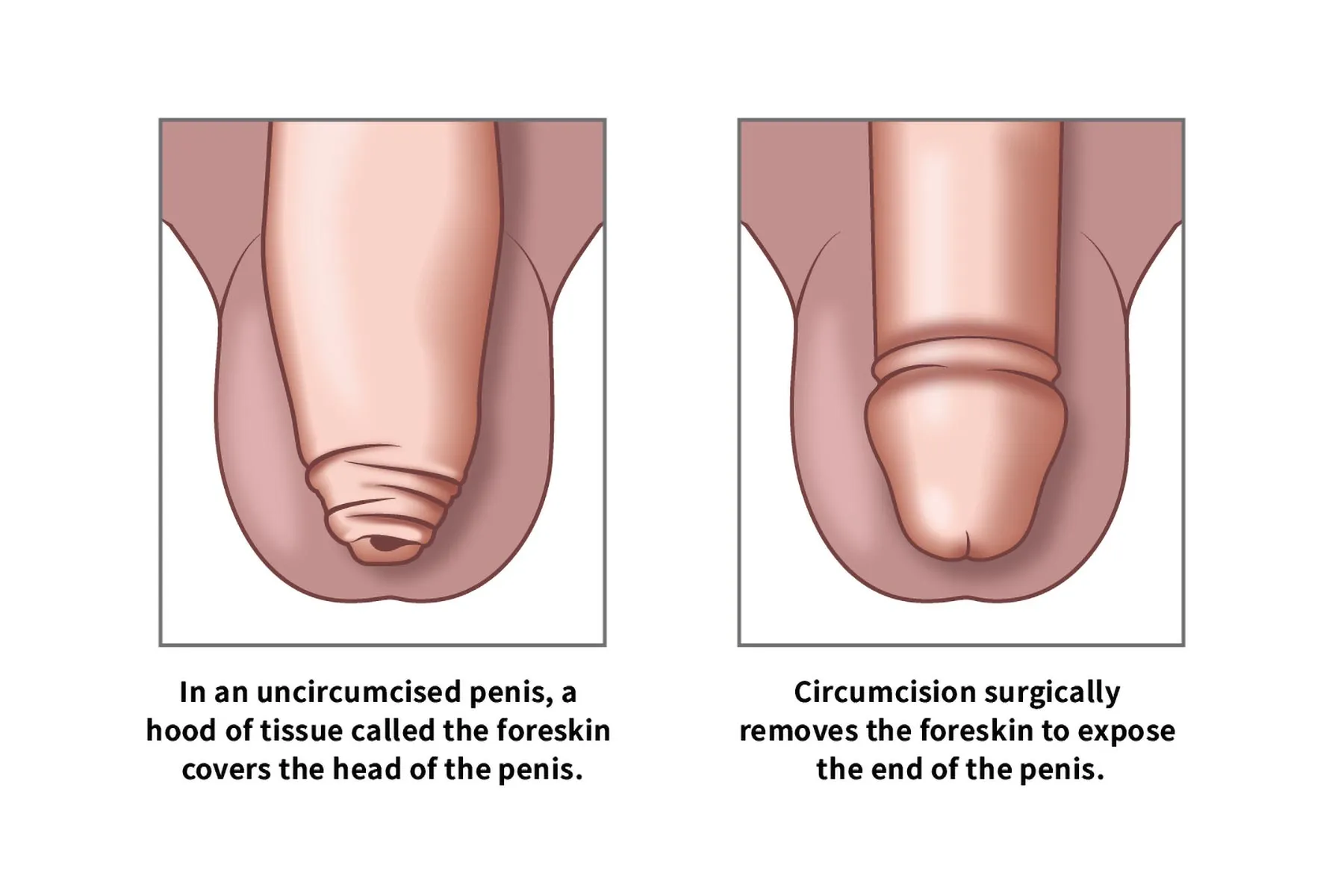The primary distinction between a circumcised (cut) and an uncircumcised (uncut) penis is the presence of foreskin covering the glans. Either state can influence cleanliness and general health outcomes.
Circumcision is the operation that removes the fold of skin over the penis head, called the foreskin.
In the United States, a large proportion of newborns with a penis undergo circumcision. This procedure may be performed for religious, cultural, social, or medical reasons, among others.
While circumcision is most frequently performed in infancy, adults sometimes choose to be circumcised as well.
Continue reading to find out how circumcision can alter the look of the penis, sexual function, and other aspects.

Does it change penis size?
Penis size is largely determined by your genetics. These genes dictate the physical traits, or phenotype, of your penis.
An uncircumcised penis can seem a bit larger, longer, and fuller when flaccid (soft) because of the foreskin. The foreskin typically accounts for about a portion of the penis length.
During erection, however, the foreskin retracts and becomes nearly invisible, so it doesn’t influence the apparent size of the penis when hard.
Penile size during an erection depends on blood flow to the erectile tissues. Removing the foreskin — a layer of skin — does not change those deeper tissues or how large the penis looks when erect.
That said, the penis may have slightly less girth when it is flaccid.
Does it alter the overall appearance?
The most noticeable cosmetic change is around the head of the penis, where the foreskin is located.
Uncircumcised
With an uncircumcised penis, the foreskin covers the glans like a protective hood when flaccid, so the tip is mostly hidden.
When erect, the foreskin pulls back and reveals the glans. The retracted foreskin often appears gathered.
Circumcised
In a circumcised penis, the foreskin is removed. The glans is exposed at all times, whether flaccid or erect. You might notice a subtle change in skin texture where the foreskin was excised.
The skin nearer the body may feel firmer and thicker, while the skin closer to the glans can be thinner and more sensitive.
Does it change how you clean it?
Experts note that in the United States, many parents opt to have newborn boys circumcised citing hygiene and health reasons. Some do so for family tradition and others for religious motivations.
Uncircumcised
An uncircumcised penis typically needs a bit more attention to cleanliness because bacteria, shed skin cells, and oils can accumulate beneath the foreskin and form smegma.
Smegma is a dense, unpleasant accumulation of dead skin cells that often has a strong odor. It can also contribute to balanitis (foreskin inflammation), which may make retracting the foreskin painful or impossible (phimosis).
Phimosis and balanitis may need medical treatment if not addressed.
Keep in mind that this guidance applies to older children and adults. Before about 10 years of age, full foreskin retraction can be difficult; never force it back for cleaning.
Circumcised
A circumcised penis does not require extra cleaning beyond normal bathing—just wash it routinely.
However, without foreskin protection the glans may be prone to dryness, chafing, or irritation. Wearing loose underwear and avoiding restrictive pants can help reduce these issues.
Does it impact sexual sensitivity?
Findings on how circumcision influences sexual sensitivity, pleasure, and performance are mixed.
Uncircumcised
Some 2016 research indicates the foreskin may be among the most touch-sensitive areas in uncircumcised men.
The foreskin can assist stimulation of the glans during intercourse by sliding along the shaft and may provide protective function. Conversely, in circumcised men the glans may become tougher over time from friction, which can reduce sensitivity.
Circumcised
A 2020 review of 94 papers found that the ventral shaft and the glans host neural pathways tied to sexual sensation and pleasure. The review also reported that some studies observed improvements in sexual pleasure, sensitivity, or function after circumcision.
Likewise, another review found no definitive evidence that circumcision has consistent effects on sexual pleasure, function, or sensitivity.
Therefore, additional research is needed to clarify how having or lacking a foreskin influences sexual sensitivity.
Does it influence lubrication?
There’s limited evidence on circumcision’s effect on lubrication.
A 2019 review reported that some female partners noticed slightly diminished vaginal lubrication after their male partners were circumcised.
The Circumcision Resource Center also suggests the foreskin may help preserve lubrication because of smegma presence.
Nonetheless, there’s no firm proof that circumcision necessitates extra lubrication.
Does it affect sperm production or fertility?
Although circumcision is an ancient procedure still in practice, its influence on sperm production and fertility is still being investigated.
A 2021 review concluded circumcision might indirectly protect male fertility by lowering the risk of genitourinary infections like phimosis, balanitis, and HIV.
However, any direct effect on sperm production is likely minimal because sperm are made in the testicles, not the penis. Lifestyle and diet are more influential on fertility and sperm counts.
Does it change infection risk?
Studies indicate circumcision can substantially reduce the risk of several infections, including:
- phimosis
- balanitis
- urinary tract infection (UTI)
- human immunodeficiency virus (HIV)
- human papillomavirus (HPV)
- herpes simplex virus
- gonorrhea
- chlamydia
- chancroid
- syphilis
That said, circumcision itself carries potential complications, such as:
- penile pain, bleeding, or swelling
- wound dehiscence (reopening of the incision)
- glans necrosis (cell death)
- meatal stenosis (narrowing of the urethral opening)
- postoperative buried penis
Circumcision in infants may also negatively affect long-term emotional and mental well-being, possibly as a response to surgical stress.
For example, those circumcised very young may show more irritability, sleep disturbances, and avoidance of the birthing parent, and later could have increased anxiety and avoidant behaviors compared with uncircumcised peers.
However, further study is necessary to fully understand circumcision’s long-term physical, social, and emotional impacts.
Does circumcision change the risk of penile cancer?
Some evidence suggests being circumcised at a young age may lower the chance of developing penile cancer later in life.
Individuals with an uncircumcised penis might face a higher penile cancer risk because smegma accumulation and phimosis are known risk factors.
If you are uncircumcised, keeping the foreskin clean and maintaining good genital hygiene can reduce the likelihood of penile complications, including infections and potentially cancer.
It’s important to remember penile cancer is rare.
Emerging research also indicates that partners with a cervix whose male partners are circumcised may have a reduced risk of cervical cancer, which is primarily caused by HPV.
»More on this:How to prevent penile cancerThe bottom line
Circumcision does not alter the risk of most conditions sufficiently to recommend it universally, nor does it substantially change overall sexual health.
The main practical difference is that an uncircumcised penis requires regular cleaning beneath the foreskin to lower infection risk and other issues.
Regardless of circumcision status, taking precautions to reduce sexually transmitted infections—such as using condoms—is important.


















Leave a Reply
You must be logged in to post a comment.